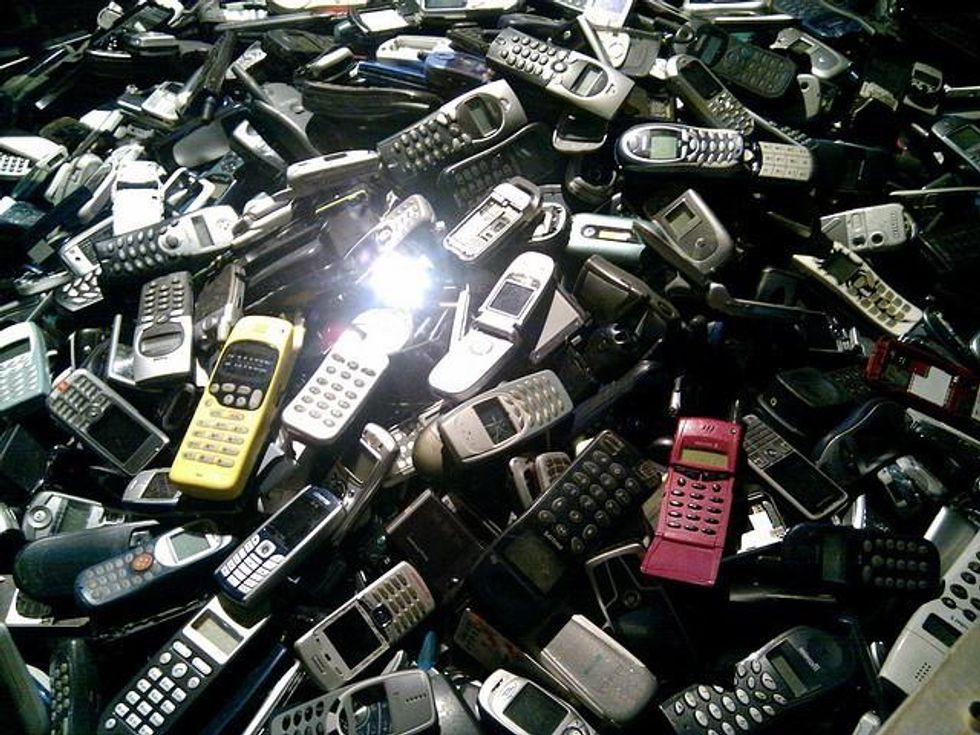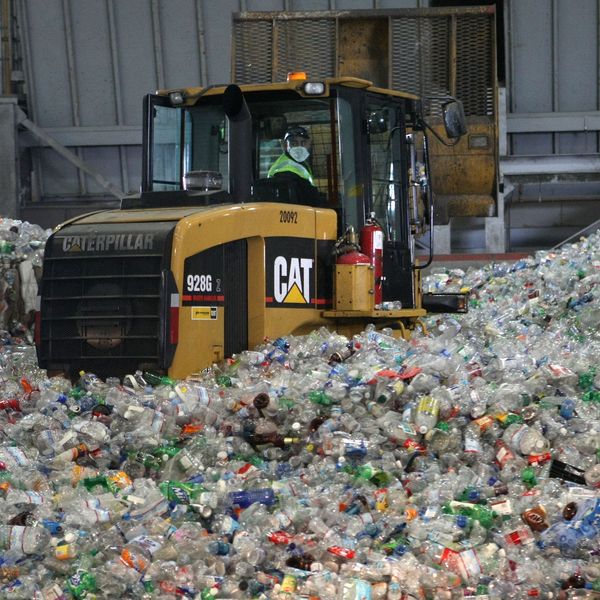UN Warns of Toxic E-Waste Surge Ahead of Holiday
Discarded devices illegally dumped on poorer nations

As many consumers use this annual gift exchange as a time to upgrade their electronic devices, a new UN report warns that, as society has trended towards a 'throw away' culture with electronics' lifespan increasingly shortening, these discarded devices have fueled an explosion in toxic e-waste.
"Christmas will see a surge in sales and waste around the world," says Ruediger Kuehr, executive secretary of the UN's Step Initiative, which was founded to tackle the growing crisis of e-waste.
E-waste--which is the discard of any electrical and electronic equipment (EEE), or anything with a battery or a cord--is now the world's fastest growing waste stream.
According to the Step report, when factoring the annual amount of discarded e-waste per person, the U.S. ranks highest among major countries (and seventh overall) with each American responsible for an average 29.8 kg of hi-tech trash each year, generating a total of 10m tonnes of waste overall.
Kuehr credits this explosion to a surge in "technological innovation," however he notes that much of this innovation has been designed with built-in obsolescence. "The lifetime of products is also shortening."
"Hardware is designed not to keep up with software, a computer's life is now under two years and mobile phones are upgraded every few months," notes an editorial at The Observer. "Many electronic devices now have parts that cannot be removed or replaced. From being cheaper to buy new devices than to repair them, it has now reached the point where it is impossible to repair them at all."
The Observer continues:
The old corporate model of "take, make and chuck" is not sustainable. Our obsession with gadgetry and technology is now driving industry to open new mines around the world, squandering energy, biodiversity and water at every stage of extraction. Enormous areas of toxic wasteland are created and left for future generations to deal with.
Consumer electronics contain a cocktail of toxic materials--including mercury, lead, precious metals and lithium batteries--much of which is illegally dumped onto poorer countries in Africa or Asia under the false pretense that it can be reused or refurbished
"Much is falsely classified as 'used goods' although in reality it is non-functional. It is often diverted to the black market and disguised as used goods to avoid the costs associated with legitimate recycling," an Interpol spokesman told the Guardian. "Treatment in these countries usually occurs in the informal sector, causing significant environmental pollution and health risks for local populations," he added.
Further, a study published by the Massachusetts Institute of Technology in conjunction with the Step report found that in 2010 the U.S. discarded 258.2m computers, monitors, TVs and mobile phones--of which only 66 percent was recycled--and nearly 120m mobile phones, only 10 percent of which was recycled.
"Meanwhile, newer phone models are racing on to the market leaving old ones likely to end up in landfills," the MIT report notes.
"What could possibly be wrong with the worldwide explosion in sales of electrical and digital equipment seen this Christmas?" the Observer editorial sardonically asks. The authors write that the burden of responsibility has too-long evaded both electronic producers and consumers.
They continue:
Designing goods so they can be easily recycled is now critical. Companies must be challenged to rethink the way they make and source their materials to ensure there is no waste from start to finish. Gadgets must be reusable and repairable, and built-in obsolescence discouraged. Companies, too, must become responsible for the entire lifecycle of their products, especially when they become obsolete.
The sale of millions of computers and mobile phones, even the electronic toys that we will give this Christmas, is being driven by an increasingly flawed business model which is leading to a depleted and polluted planet.
_____________________
An Urgent Message From Our Co-Founder
Dear Common Dreams reader, The U.S. is on a fast track to authoritarianism like nothing I've ever seen. Meanwhile, corporate news outlets are utterly capitulating to Trump, twisting their coverage to avoid drawing his ire while lining up to stuff cash in his pockets. That's why I believe that Common Dreams is doing the best and most consequential reporting that we've ever done. Our small but mighty team is a progressive reporting powerhouse, covering the news every day that the corporate media never will. Our mission has always been simple: To inform. To inspire. And to ignite change for the common good. Now here's the key piece that I want all our readers to understand: None of this would be possible without your financial support. That's not just some fundraising cliche. It's the absolute and literal truth. We don't accept corporate advertising and never will. We don't have a paywall because we don't think people should be blocked from critical news based on their ability to pay. Everything we do is funded by the donations of readers like you. Will you donate now to help power the nonprofit, independent reporting of Common Dreams? Thank you for being a vital member of our community. Together, we can keep independent journalism alive when it’s needed most. - Craig Brown, Co-founder |

As many consumers use this annual gift exchange as a time to upgrade their electronic devices, a new UN report warns that, as society has trended towards a 'throw away' culture with electronics' lifespan increasingly shortening, these discarded devices have fueled an explosion in toxic e-waste.
"Christmas will see a surge in sales and waste around the world," says Ruediger Kuehr, executive secretary of the UN's Step Initiative, which was founded to tackle the growing crisis of e-waste.
E-waste--which is the discard of any electrical and electronic equipment (EEE), or anything with a battery or a cord--is now the world's fastest growing waste stream.
According to the Step report, when factoring the annual amount of discarded e-waste per person, the U.S. ranks highest among major countries (and seventh overall) with each American responsible for an average 29.8 kg of hi-tech trash each year, generating a total of 10m tonnes of waste overall.
Kuehr credits this explosion to a surge in "technological innovation," however he notes that much of this innovation has been designed with built-in obsolescence. "The lifetime of products is also shortening."
"Hardware is designed not to keep up with software, a computer's life is now under two years and mobile phones are upgraded every few months," notes an editorial at The Observer. "Many electronic devices now have parts that cannot be removed or replaced. From being cheaper to buy new devices than to repair them, it has now reached the point where it is impossible to repair them at all."
The Observer continues:
The old corporate model of "take, make and chuck" is not sustainable. Our obsession with gadgetry and technology is now driving industry to open new mines around the world, squandering energy, biodiversity and water at every stage of extraction. Enormous areas of toxic wasteland are created and left for future generations to deal with.
Consumer electronics contain a cocktail of toxic materials--including mercury, lead, precious metals and lithium batteries--much of which is illegally dumped onto poorer countries in Africa or Asia under the false pretense that it can be reused or refurbished
"Much is falsely classified as 'used goods' although in reality it is non-functional. It is often diverted to the black market and disguised as used goods to avoid the costs associated with legitimate recycling," an Interpol spokesman told the Guardian. "Treatment in these countries usually occurs in the informal sector, causing significant environmental pollution and health risks for local populations," he added.
Further, a study published by the Massachusetts Institute of Technology in conjunction with the Step report found that in 2010 the U.S. discarded 258.2m computers, monitors, TVs and mobile phones--of which only 66 percent was recycled--and nearly 120m mobile phones, only 10 percent of which was recycled.
"Meanwhile, newer phone models are racing on to the market leaving old ones likely to end up in landfills," the MIT report notes.
"What could possibly be wrong with the worldwide explosion in sales of electrical and digital equipment seen this Christmas?" the Observer editorial sardonically asks. The authors write that the burden of responsibility has too-long evaded both electronic producers and consumers.
They continue:
Designing goods so they can be easily recycled is now critical. Companies must be challenged to rethink the way they make and source their materials to ensure there is no waste from start to finish. Gadgets must be reusable and repairable, and built-in obsolescence discouraged. Companies, too, must become responsible for the entire lifecycle of their products, especially when they become obsolete.
The sale of millions of computers and mobile phones, even the electronic toys that we will give this Christmas, is being driven by an increasingly flawed business model which is leading to a depleted and polluted planet.
_____________________

As many consumers use this annual gift exchange as a time to upgrade their electronic devices, a new UN report warns that, as society has trended towards a 'throw away' culture with electronics' lifespan increasingly shortening, these discarded devices have fueled an explosion in toxic e-waste.
"Christmas will see a surge in sales and waste around the world," says Ruediger Kuehr, executive secretary of the UN's Step Initiative, which was founded to tackle the growing crisis of e-waste.
E-waste--which is the discard of any electrical and electronic equipment (EEE), or anything with a battery or a cord--is now the world's fastest growing waste stream.
According to the Step report, when factoring the annual amount of discarded e-waste per person, the U.S. ranks highest among major countries (and seventh overall) with each American responsible for an average 29.8 kg of hi-tech trash each year, generating a total of 10m tonnes of waste overall.
Kuehr credits this explosion to a surge in "technological innovation," however he notes that much of this innovation has been designed with built-in obsolescence. "The lifetime of products is also shortening."
"Hardware is designed not to keep up with software, a computer's life is now under two years and mobile phones are upgraded every few months," notes an editorial at The Observer. "Many electronic devices now have parts that cannot be removed or replaced. From being cheaper to buy new devices than to repair them, it has now reached the point where it is impossible to repair them at all."
The Observer continues:
The old corporate model of "take, make and chuck" is not sustainable. Our obsession with gadgetry and technology is now driving industry to open new mines around the world, squandering energy, biodiversity and water at every stage of extraction. Enormous areas of toxic wasteland are created and left for future generations to deal with.
Consumer electronics contain a cocktail of toxic materials--including mercury, lead, precious metals and lithium batteries--much of which is illegally dumped onto poorer countries in Africa or Asia under the false pretense that it can be reused or refurbished
"Much is falsely classified as 'used goods' although in reality it is non-functional. It is often diverted to the black market and disguised as used goods to avoid the costs associated with legitimate recycling," an Interpol spokesman told the Guardian. "Treatment in these countries usually occurs in the informal sector, causing significant environmental pollution and health risks for local populations," he added.
Further, a study published by the Massachusetts Institute of Technology in conjunction with the Step report found that in 2010 the U.S. discarded 258.2m computers, monitors, TVs and mobile phones--of which only 66 percent was recycled--and nearly 120m mobile phones, only 10 percent of which was recycled.
"Meanwhile, newer phone models are racing on to the market leaving old ones likely to end up in landfills," the MIT report notes.
"What could possibly be wrong with the worldwide explosion in sales of electrical and digital equipment seen this Christmas?" the Observer editorial sardonically asks. The authors write that the burden of responsibility has too-long evaded both electronic producers and consumers.
They continue:
Designing goods so they can be easily recycled is now critical. Companies must be challenged to rethink the way they make and source their materials to ensure there is no waste from start to finish. Gadgets must be reusable and repairable, and built-in obsolescence discouraged. Companies, too, must become responsible for the entire lifecycle of their products, especially when they become obsolete.
The sale of millions of computers and mobile phones, even the electronic toys that we will give this Christmas, is being driven by an increasingly flawed business model which is leading to a depleted and polluted planet.
_____________________

